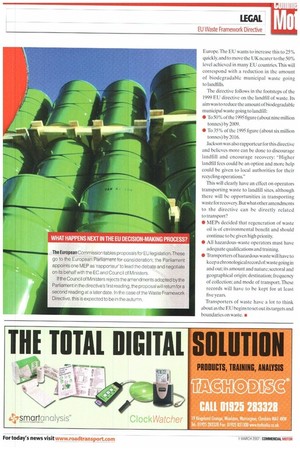Waste not want not
Page 36

Page 37

If you've noticed an error in this article please click here to report it so we can fix it.
The EU Waste Framework Directive is set to boost recycling of waste, assuming that it becomes law in 2009. David Craik reviews the directive from an operator's point of view.
Last month the European Parliament voted on the first reading of the EU Waste Framework Directive, which is designed to set up a framework for dealing with the increasing amount of waste produced across the EU. According to the European Parliament, 3.5 tonnes of solid waste are thrown away each year for every man,woman and child in the Union.
The MEPs adopted the following key amendments to the directive: • A hierarchy in the treatment of waste should be established for the first time in EU legislation. This will lay down an order of preference for waste operations to be referred to in planning decisions. It is to have five levels: prevention and reduction of waste; re-use of waste; recycling;recovery; and safe and environmentally sound disposal.The hierarchy is currently regarded as a guide for waste operators but with no legal force.
• MEPs plan to boost energy efficiency by setting out a scale of standards to be met by incinerators. However, a majority of MEPs rejected the idea that incinerators should be regarded as recovery.
• Each member state will have to set waste prevention targets by 2010—and hit them by 2020.The idea is to stabilise waste production at 2008 levels by 2012, and not increase it; member states will have to draw up national prevention programmes within 18 months of the directive coming into force.
• MEPs introduced a 50% target for recycling municipal waste by 2020 — with a 70% recycling target for the re-use of waste from the construction, demolition and manufacturing sectors. Conservative South West MEP Caroline Jackson, the rapporteur of the directive for the Parliament (see panel), believes the directive will lay down three landmarks in European law: "Planning decisions shouldrefer to the hierarchy, but this can he departed from as it needs to be flexible.The setting of targets for prevention of waste should help stabilise waste production — there is nothing in EU law which says this at the moment. Thirdly, recovery as opposed to disposal will gain more acceptance."
Targets for recycling European Parliament figures show that in 2004/05 English households recycled 23% of their waste; this is one of the lowest rates in Europe.`The EU wants to increase this to 25% quickly, and to move the UK nearer to the 50% level achieved in many EU countries. This will correspond with a reduction in the amount of biodegradable municipal waste going to landfills.
The directive follows in the footsteps of the 1999 EU directive on the landfill of waste. Its aim was to reduce the amount of biodegradable municipal waste going to landfill: • To 50% of the 1995 figure (about nine million tonnes) by 2009.
• To 35% of the 1995 figure (about six million tonnes) by 2016.
Jackson was also rapporteur for this directive and believes more can be done to discourage landfill and encourage recovery: "Higher landfill fees could be an option and more help could be given to local authorities for their recycling operations."
This will clearly have an effect on operators transporting waste to landfill sites, although there will be opportunities in transporting waste for recovery. But what other amendments to the directive can be directly related to transport?
• MEPs decided that regeneration of waste oil is of environmental benefit and should continue to be given high priority.
• All hazardous-waste operators must have adequate qualifications and training.
• Transporters of hazardous waste will have to keep a chronological record of:waste going in and out; its amount and nature; sectoral and geographical origin; destination; frequency of collection; and mode of transport. These records will have to be kept for at least five years.
Transporters of waste have a lot to think about as the EU begins to set out its targets and boundaries on waste. •


























































































































































































